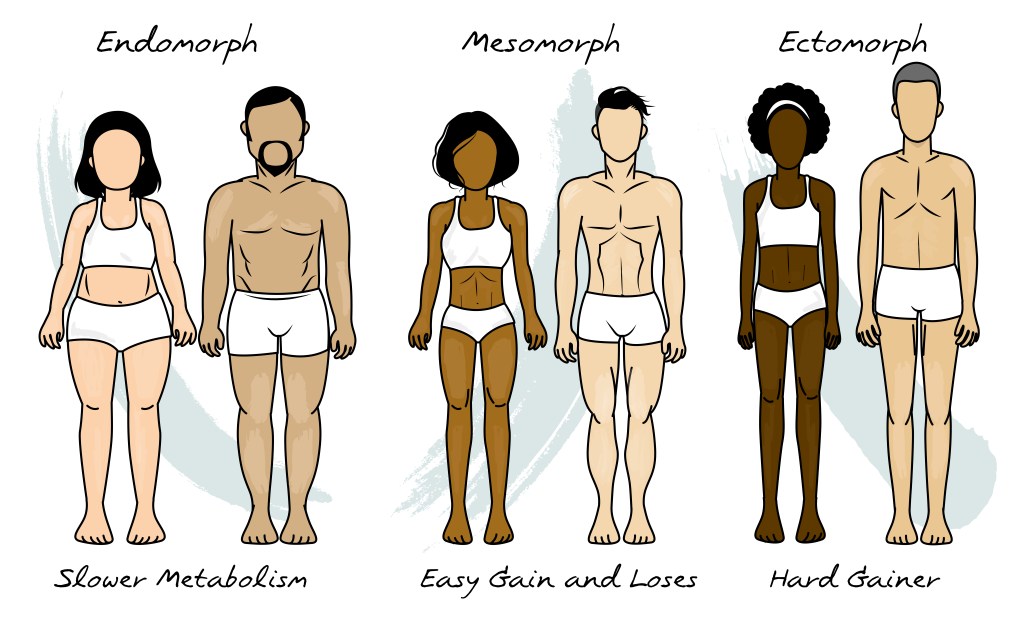At a glance
Genetics primarily determine your metabolic body type. The three metabolic body types are ectomorph, mesomorph, and endomorph, each with distinct characteristics. However, lifestyle habits, such as diet and exercise, can influence metabolism and contribute to mixed metabolic body types.
Your metabolic body type is primarily determined by your genetics. But did you know that your metabolism significantly impacts the shape and size of your body?
Understanding how your metabolic body type impacts your weight and body composition can help you make confident diet and lifestyle choices to achieve your weight goals and support a healthy body.
Find out your metabolic body type and what this tells you about your ideal diet and exercise program.
What are the three metabolic body types?
The concept of metabolic body types is based on the relationship between your metabolism and your nervous system.
Your metabolism determines how quickly and effectively your body converts fuel to energy. How fast or slow your metabolism works greatly depends on your genetics.
However, lifestyle factors, such as diet, sleep, and exercise, can significantly boost or decrease the effectiveness of your metabolism.
Your autonomic nervous system regulates involuntary processes like heart rate, breathing, and digestion. It’s balanced by two opposing parts: the sympathetic nervous system and the parasympathetic nervous system.
The sympathetic nervous system is activated during periods of high stress, as it prepares your body to respond to danger by increasing your heart rate and blood pressure and tensing your muscles.
The parasympathetic nervous system creates balance during periods of low stress, relaxing your muscles and lowering your heart rate and blood pressure.
Most people have one dominant sympathetic nervous system trait, which determines energy expenditure. A dominant sympathetic nervous system results in a higher energy requirement. In contrast, a dominant parasympathetic nervous system is an energy-conserving trait.
The combination of your metabolism and your dominant nervous system trait determines your metabolic body type. There are different body types, each with its own individual characteristics of weight, body fat distribution, and muscle mass.
Understanding your body type helps you achieve a healthy weight and supports your well-being.

Ectomorph body type explained
Ectomorph body types typically have a narrow frame and thin, lean bodies with small shoulders and flat chests. This body type indicates a fast metabolism, and ectomorphs often find it hard to gain weight no matter how much they eat.
The ectomorph has lean muscles and the lowest body fat compared to the other body types. The right diet and exercise routine help ectomorphs to gain muscle easily and quickly.
Ectomorph body type characteristics:
- Small frame and shoulders
- Lean body
- Flat chest
- Often taller than average
- Fast metabolism
What diet and exercise benefit ectomorphs?
Ectomorphs burn calories fast and benefit from a nutrient-dense, high-quality diet like Healthy Keto®. Keto’s high-fat and medium-protein ratio is ideal for this metabolic type and provides plenty of nutrient-rich whole foods and energy.
How much protein an ectomorph body type should consume depends on exercise habits and frequency. More exercise may require more protein intake to keep a healthy weight and gain muscle.
Strength training and high-intensity interval training (HIIT) sessions build lean muscle mass and are optimal workouts for this body type. Avoid exercising daily to give your body time to recover.
You may have heard that an ectomorph body type can process carbohydrates quickly, making carbs an ideal energy source for this body type. This is somewhat oversimplified. A high-carb intake without rigorous exercise, like endurance training, can result in a skinny-fat body for ectomorphs.
When you eat carbohydrates, your body releases insulin in response to increased blood sugar.
Insulin regulates blood sugar but also shifts your metabolism into fat-storage mode. Consuming too many carbohydrates leads to a soft-ectomorph body, a skinny body with too much belly fat.
Unless you frequently engage in endurance sports, avoid all processed carbs and whole grains and focus on complex carbs in the form of vegetables instead. This provides high-quality nutrients, prevents belly fat, and supports muscle gain for this metabolic type.

Mesomorph body type explained
Mesomorph body types have a medium frame and typically upright posture. This metabolic type develops muscles quickly and often has strong arms and legs.
Mesomorphs tend to have more muscle than fat and a naturally athletic body with an efficient metabolism that supports a healthy weight.
Mesomorph body type characteristics:
- Medium, rectangular body frame
- Strong leg muscles
- Moderate amounts of body fat
- Lose weight easily
- Efficient metabolism
What diet and exercise benefit mesomorphs?
The genetic makeup of mesomorphs typically relates to an ideal basal metabolic rate, meaning this metabolic body type is very efficient at converting food into energy.
With the correct diet and workout routine, mesomorphs generally find losing weight easy.
Because mesomorph body types gain muscle easily, a nutrient-rich ketogenic diet is ideal for maintaining lean muscle mass and providing plenty of nutrients and energy.
This body type benefits from plenty of healthy oils and moderate amounts of protein and typically thrives when consuming fewer carbs.
Intermittent fasting (IF) is an excellent tool for mesomorphs to promote a healthy body. IF supports a well-working metabolism, balances hormone levels, and boosts energy and cognition.
Mesomorphs achieve great muscle definition by incorporating strength training with short rest periods between sets into their fitness routine.

Endomorph body type explained
The endomorph body type is characterized by a slow metabolism, resulting in more overall body fat than other metabolic types. Endomorphs have round bodies and larger bone structures with thicker arms.
Endomorphs don’t tend to develop muscle mass quickly, store more body fat, and find it difficult to lose weight.
Endomorph body type characteristics:
- Round body
- Medium to large joints
- Weaker upper body muscles
- Prone to excess body fat
- Gain fat easily
What diet and exercise benefit endomorphs?
Endomorphs are prone to blood sugar imbalances and don’t tolerate carbohydrates well. A low-carb eating plan like keto is the perfect metabolic diet for this body type.
Endomorphs tend to have larger waistlines and belly fat. Research published in Frontiers in Endocrinology suggests that the keto diet is excellent for counteracting a slow metabolism, helping weight loss, and preventing weight gain.1
Endomorphs benefit from avoiding processed foods, starchy carbs, and whole grains to lose extra body fat. A diet rich in healthy oils, saturated fat, and enough protein supports healthy calorie intake and lowers hunger and cravings.
Light cardio and strength training are ideal workout routines for this metabolic body type and help lose weight fast.

Mixed metabolic body types explained
Humans are complex, and it isn’t surprising that your body may not fit neatly into one of these body type categories.
Lifestyle factors, such as diet and exercise, health conditions, or medications can push your dominant body type to overlap with another metabolic body type.
Here are some common mixed metabolic body types:
Ecto-mesomorphs
An ecto-mesomorph has a narrow waist but builds muscle quickly. This metabolic type is generally very lean, muscular, and athletic.
Meso-endomorphs
Meso-endomorphs have a large frame and are strong but lack well-defined muscles. Their genetic makeup helps to build muscle but also predisposes them to gain weight easily.
Research published in Reviews in Environmental Health found that the meso-endomorph body type is the most common metabolic body type for women.2
Ecto-endomorphs
An ecto-endomorph typically is a naturally lean person who has gained weight due to dietary choices and lack of exercise. This metabolic body type often has an apple-shaped frame with excess fat around the waistline.

Metabolic vs. hormonal body types
The three metabolic body types are structurally classified by body shape and composition. They indicate how efficiently your metabolism is converting food to energy.
While genetics plays a significant role in determining your dominant body type, dietary and lifestyle choices also influence your body composition.
Hormonal body types, on the other hand, explain the relationship between your hormone levels and fat distribution. Hormones profoundly impact your body composition and regulate how your body produces and stores energy.
Depending on your hormone levels, your body may burn fat instead of sugar for energy or store excessive energy in the form of fat. This explains why some people find it easy to lose weight while others struggle with weight loss no matter what they do.
Understanding how imbalanced hormone production influences your fat distribution helps you to formulate a diet that benefits your health and supports a healthy weight.

Here are the five hormonal body types.
Adrenal body type
The adrenal body type is generally characterized by a sagging belly that doesn’t respond to any dietary changes. This body type is caused by elevated levels of the stress hormone cortisol produced in your adrenal glands.
Stress-reduction techniques, plenty of sleep, and a nutrient-rich diet are essential for the adrenal body type.
Thyroid body type
Thyroid body types typically gain weight all over the body. Your thyroid hormones regulate how fast or slow your metabolism works and how your body produces energy.
Elevated estrogen levels and sluggish liver function result in imbalanced thyroid hormones, resulting in a slow metabolism and weight gain.
Liver body type
The liver body type is characterized by a protruding belly and is linked to low levels of human growth hormone. Human growth hormone is necessary for fat-burning. Low levels lead to weight gain and difficulty losing weight.
If you suffer from liver damage, fatty liver, or cirrhosis, you are more likely to develop a liver body type and should avoid alcohol and excessive protein.
Liver body types should focus on a liver-healthy, nutrient-dense diet that’s high in cruciferous vegetables like cabbage, broccoli, and Brussels sprouts.
Ovary body type
Ovary body types tend to carry weight around the hips, thighs, and arms. Only women develop this particular body type, most commonly caused by estrogen dominance.
Excessive estrogen levels impact fat distribution and basal metabolic rate, making weight loss difficult.
A hormone-balancing diet rich in cruciferous vegetables like broccoli, mustard greens, and cabbage is an excellent option for the ovary body type.
Pancreas body type
The pancreas body type is one of the most common body types and closely resembles the adrenal body type, with a sagging belly being the main symptom.
The pancreas body type is likely insulin resistant as a result of chronic blood sugar imbalances and benefits from a low-carb, high-fat diet like keto.
Key takeaways
- The three primary metabolic body types are ectomorph, mesomorph, and endomorph, characterized by lean, medium, and rounded frames.
- Understanding your metabolic body type helps you formulate a diet and workout program that allows you to see results quickly.
- You may fall into a mixed metabolic type category, such as ectomorph-mesomorph, mesomorph-endomorph, or ectomorph-endomorph, therefore, adjust your diet as needed.
- There are five hormonal body types, which include adrenal, thyroid, liver, ovary, and pancreas, defined by hormonal imbalances and their effects on fat distribution.
- Addressing underlying hormonal imbalances with a nutrient-dense, low-carb diet can reduce the risk of chronic disease and help you reach your weight goals more quickly.
FAQ
1. What are the three metabolic body types?
The three main metabolic body types are ectomorph, endomorph, and mesomorph.
2. How do I know my metabolic body type?
You can determine your metabolic body type by your stature, body composition, and body shape. How easily you lose or gain, fat also indicates your metabolic body type and how fast or slow your metabolism works.
It isn’t unusual to fall into more than one metabolic body type category. Ecto-mesomorphs, meso-endomorphs, and ecto-endomorphs are all common mixed metabolic body types.
3. What’s the difference between metabolic and hormonal body types?
Metabolic body types explain the relationship between your metabolism and body composition and are predominantly determined by your genetics.
Hormonal body types develop in response to hormonal imbalances affecting your body’s fat distribution.
4. What is the ectomorph body type?
Ectomorph body types are characterized by a narrow body shape and thin, lean body composition. They often have small shoulders and flat chests.
This body type typically has a fast metabolism, and ectomorphs find it hard to gain weight no matter how much they eat. Ectomorph body types have lean muscles and the lowest body fat compared to mesomorphs and endomorphs.
5. What is the mesomorph body type?
Mesomorph body types generally have medium-sized, rectangular frames and moderate amounts of body fat. This metabolic type develops muscles quickly and often has strong arms and legs.
Mesomorphs have more muscle than fat and have a naturally athletic body with an efficient metabolism that supports a healthy weight.
6. What is the endomorph body type?
The endomorph body type is characterized by a slow metabolism and more body fat than other metabolic types. Endomorphs often have round bodies and a larger bone structure with thicker arms.
Endomorphs find it hard to develop muscle mass and store more body fat. This body type benefits from eating fewer calories and following a low-carb, high-fat ketogenic diet.
7. Are metabolic body types the same as hormonal body types?
No, metabolic body types aren’t the same as hormonal body types. While everyone has a genetically determined metabolic body type, not everyone develops a hormonal body type.
Hormonal body types develop in response to underlying hormone imbalances caused by stress, high-carb diets, environmental pollutants, or a sluggish liver.
8. What are the five hormonal body types?
The five hormonal body types are adrenal body type, ovary body type, thyroid body type, pancreas body type, and liver body type.








